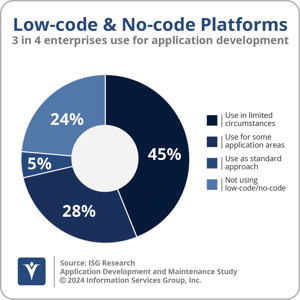In the evolving landscape of business operations, intelligent automation has emerged as a key driver of productivity, operational efficiency and workforce satisfaction. Each facet of an organization perceives the value of automation through the lens of its unique objectives and goals. In a previous perspective, I shared the reasons why enterprise organizations are leaning towards automating business and technology workflows, highlighting three pivotal business and technology trends that are shaping the decisions of CIOs and IT leaders. Building on that foundation, this perspective shifts the spotlight to the next crucial question: What areas within the enterprise are ripe for automation? Let’s explore.
There are a variety of approaches to automation within the context of business processes. Organizations can purchase prebuilt applications that include automated processes such as notifying customers when a support or service issue has been submitted. Custom-coded solutions are also popular: more than 3 in 4 organizations in the ISG Application Development and Maintenance Buyer Behavior Study are using low-code and no-code platforms for application development.
More recently, a variety of low-code and no-code technologies have become popular. These tools are designed to make the development process easier and to enable a broader audience of users. Process automation tools, also referred to as robotic process automation (RPA), offer a way to connect various business systems and processes. In effect, RPA provides the “glue” between those systems and processes.
audience of users. Process automation tools, also referred to as robotic process automation (RPA), offer a way to connect various business systems and processes. In effect, RPA provides the “glue” between those systems and processes.
Note that there are challenges associated with each of these approaches to automation. Prebuilt applications do not capture the competitive differentiation that makes each organization unique. Implementing custom applications can be expensive, time-consuming and often requires specialized skills. Low-code and no-code approaches attempt to minimize the skills challenge, but still require that everyone must think like a programmer. If something unexpected happens, the automations will typically fail. This means the developers must program for every possible scenario.
Automation technologies can significantly enhance business value and help achieve IT goals within an enterprise organization. By identifying specific areas where automation can be applied, the IT leader creates a roadmap that incorporates technology to achieve business goals. Here are some examples of enterprise organization activities primed and ready for intelligent automation:
Data Management and Analytics: Automation can streamline data ingestion and transformation processes. It can also automate the generation of regular reports and dashboards, saving time and enhancing data accuracy.
Infrastructure Management: Automation can be used to provision new servers, scale resources up or down as needed, and perform routine maintenance tasks. It can also automate network configuration changes and updates to improve consistent and secure connectivity.
Security and Compliance: Automation can enhance security by automating the deployment of patches and updates and managing user access. It can also automate document approval processes to streamline decision-making and improve compliance.
Customer Support and Engagement: Automation can improve customer support by automating ticket routing, improving chatbots and self-service portals, and automating responses and case routing for customer inquiries and issues.
Business Process Automation: Automation can streamline routine business processes like invoice processing, HR onboarding, procurement and purchase order processing. It can also automate communications with suppliers for order updates and inventory management.
Software Development: Automation can improve software quality and release cycles through continuous integration and deployment. It can also monitor application performance and automatically adjust DevOps resources as needed.
Resource Management: Automation can optimize enterprise resource allocation and cost by tracking and managing hardware and software assets, reordering supplies and equipment when stock levels fall below predefined thresholds, and automating workforce scheduling.
Sales and Marketing: Automation can improve sales and marketing efficiency by automating lead scoring and nurturing processes.
Financial Management: Automation can strengthen financial management by automating expense approval and reconciliation processes and supporting strategic decision-making through financial data collection and analysis.
Automation technologies offer a wide range of practical uses within an enterprise organization. By strategically implementing these technologies, organizations can enhance efficiency, productivity and cost-effectiveness.
The strategic implementation of intelligent automation technologies hinges on the clear identification of business objectives and goals. These technologies can add value to the organization when applied to the right areas. As I have highlighted, the potential applications are vast, spanning from data management to customer support, infrastructure management and beyond.
For a CIO or IT leader looking to utilize these technologies, the following steps are recommended:
- Identify key areas: Evaluate your organization’s workflows and processes to identify key areas where automation can add value.
- Set clear objectives: Define clear objectives and goals for each area of automation. These could be related to improving productivity, enhancing operational efficiency or boosting workforce satisfaction.
- Develop a roadmap: Based on the identified areas and objectives, develop a roadmap for implementing intelligent automation technologies.
To delve deeper into the world of intelligent automation, I recommend reviewing our annual market agenda for Digital Technology. It provides an overview of the latest trends, insights and advancements in this field. By staying informed and proactive, organizations can harness the power of automation to drive growth and success.
Regards,
Jeff Orr
 audience of users. Process automation tools, also referred to as robotic process automation (RPA), offer a way to connect various business systems and processes. In effect, RPA provides the “glue” between those systems and processes.
audience of users. Process automation tools, also referred to as robotic process automation (RPA), offer a way to connect various business systems and processes. In effect, RPA provides the “glue” between those systems and processes.








